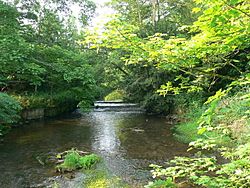Cound Brook facts for kids
Quick facts for kids Cound Brook |
|
|---|---|

Cound Brook viewed from Longnor Bridge
|
|
| Country | England |
| Region | West Midlands |
| County | Shropshire |
| Cities | Dorrington, Condover, Cantlop, Cound |
| Physical characteristics | |
| Main source | All Stretton 176 m (577 ft) |
| River mouth | River Severn, near Eyton on Severn 41 m (135 ft) |
| Length | 40.5 km (25.2 mi) |
| Discharge (location 2) |
|
The Cound Brook (pronounced COOnd) is a small river in Shropshire, England. It is a tributary, which means it flows into a larger river. The Cound Brook joins the famous River Severn.
This brook starts in the Stretton Hills. It then travels about 40.5 kilometers (25 miles) across the flat lands of southern Shropshire. Finally, it flows into the River Severn near Eyton on Severn.
The amount of water in the Cound Brook changes a lot. In a dry summer, it can be slow and quiet. But in winter or spring, it can become a fast-flowing stream. The brook has overflowed its banks many times in the past. Because of this, local river authorities now watch it closely.
Many bridges cross the Cound Brook along its path. Two of these are very old and special iron bridges. Some roads even cross the brook through shallow water called fords.
The brook gets its name from Cound, the last village it passes through before joining the River Severn. Interestingly, another village, Condover, might have been named after the brook a long time ago. The Coundmoor Brook is a smaller stream that flows into the Cound Brook near Cound.
Contents
Journey of the Cound Brook
The Cound Brook starts its journey in the Stretton Hills. It then flows past several villages.
It goes to the east of Leebotwood and to the west of Longnor. Near Longnor, there was once a Medieval deer park. The brook continues past Dorrington village.
At a place called Stapleton, the Cound Brook changes direction. It then starts flowing towards the east.
Passing Through Condover
The Cound Brook flows through the historic village of Condover. This village has a special conservation area and many Listed buildings. These are buildings that are protected because they are important.
A water mill was recorded in Condover along the Cound Brook a very long time ago. This was mentioned in the Domesday Book, which was a big survey of England made in 1086. After Condover, the brook flows southeast through Boreton.
Amazing Iron Bridges
The Cound Brook is famous for two old iron bridges designed by a very clever engineer named Thomas Telford.

Cantlop Bridge
North of the village of Cantlop, you can find the Cantlop Bridge. This is a special bridge made of cast iron. Thomas Telford designed and built it in 1818.
It was originally a road bridge for people and carts to cross the Cound Brook. Today, it is a historic monument. A newer bridge next to it carries the modern road.
Coundarbour Bridge
The Cound Brook then flows through the village of Cound. Here, it passes under another iron bridge called the Coundarbour bridge. This bridge was also designed and built by Thomas Telford, but even earlier, in 1797.
The Coundarbour bridge is very special. It is the oldest iron bridge in the world that is still used every day by cars and people! The famous Iron Bridge in Ironbridge, built by Abraham Darby III, closed to vehicles in 1934 and is now only for people walking.
Joining the River Severn
After passing under these historic bridges, the Cound Brook takes a winding path. It flows across a low, flat area that can sometimes flood.
Finally, the Cound Brook flows into the River Severn. This happens a short distance west of Eyton on Severn. It is also less than a mile south from Wroxeter, which has the ruins of an old Roman city. This area is also close to the northern end of Watling Street, an ancient Roman road that started in Dover.

